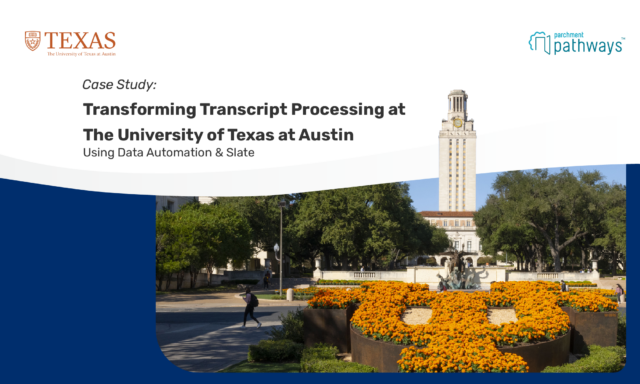When it comes to transfer and mobility in higher education, the news remains grim. In Fall 2022, upward transfer fell by 7.5%, continuing the downward trend we saw throughout the pandemic. But in a bright spot, other transfer pathways showed signs of rebound, with four-year lateral transfers increasing by 2% and 2-year lateral transfers growing by .3%.
Many institutions rely on transfer students as a segment of their overall enrollment, especially when these students transfer vertically from a 2-year to a 4-year institution. For these institutions, continued declines in upward transfer are worrying.
But for other institutions, transfer raises different concerns. Nearly 40% of first-time students transfer institutions at some point in their higher education journey, which translates into lost revenue and lower persistence rates.
Transferring from institution to institution is not an easy process, causing students to become frustrated by the complexity of it. And many times, transfer students lose credits, which translates into wasted time and money. In fact, a recent study that we conducted entitled Barriers to On-Time Completion reported that 33% of current students lost at least half of their credits when they transferred institutions.
Losing credits during the transfer process is certainly frustrating for students and it impacts their ability to graduate on time. But our survey also revealed that course availability is a barrier students struggle to overcome as well. When students are waitlisted or are unable to enroll in the courses they need, they may feel like changing schools is the only way for them to stay on track.
Overcoming the Challenges With Course Availability
However, some students who struggle with course availability explore a different option, one where they take courses at other institutions to “fill the gap.” In the same study, 41% of current students reported that they took a class at another institution because it wasn’t available at their home institution, while 27% of recent graduates did the same.
Unfortunately, students who take a course or two at another institution experience the same frustrations as transfer students. From not knowing which credits will—and will not—transfer, to frustrating and unclear processes, it’s clear that something needs to change. To address these challenges, and to provide an alternative to transferring schools, many institutions are exploring course sharing.
Course sharing is a strategy where two or more institutions collaborate to make their courses available to each other’s students to count for credit at their home institution. And while course sharing may sound similar to traditional transfer, it’s different in three important ways.
3 Ways Course Sharing Differs From Traditional Transfer
1. Course Sharing Offers Students Alternative Ways to Stay on Track
Using course sharing, institutions offer their students ways to easily gain access to the courses they need without the hassle—and potential credit loss—associated with traditional transfer. Using a course-sharing platform that provides visibility into transferability, students benefit from knowing, before they spend time and money, that the courses they are taking will transfer and count towards their degree.
Institutions benefit as well. Not only are home institutions retaining students while helping them stay on track, but they are also doing so without the incremental costs associated with adding additional courses, sections, or faculty to their schedule. Teaching institutions benefit from the boost in enrollment, as well as the ability to fill empty seats in their classrooms.
2. Course Sharing Is Powered by Technology
At the core of the course-sharing process is technology, which, in addition to providing access to a searchable online catalog of shared courses and sections (sometimes referred to as a course exchange), can also provide transferability information for students. This way, students have visibility into the information they need in order to determine if—and more importantly, how—a course they want to take at another institution transfers to their home institution and counts towards their degree requirements.
When course-sharing solutions are integrated with the teaching school’s SIS, they can also provide real-time seat counts, saving students the hassle and frustration of trying to register for a section of a course only to find out it is already full. Having this information, students can easily find a transferable course that will count towards their degree, select an open section, and register for it immediately. They can even pay tuition and/or initiate the financial aid process through the course-sharing solution.
3. Course Sharing Reduces Manual Processes
The traditional transfer process can involve a lot of paper and online forms, along with manual, time-consuming processes for both administrators and for students. With course sharing, that’s not the case.
As mentioned above, course-sharing solutions provide the ability for students to search for a course that fulfills their degree requirements in their institution’s course exchange. The results could show both courses offered at their home institution or courses offered at other institutions in the network. Once students find the course they need and a section that fits their schedule, they will immediately know if it will count towards their degree. If it does, they can select it and register in just a few clicks. With SIS integration, the course-sharing solution can automatically enroll the student at the teaching institution and register them in the section they selected – no additional forms, emails, or phone calls required.
On the administrative side, course-sharing solutions enable institutions to maintain a real-time catalog, or database, of courses and sections. They can even control visibility down to the individual section as they choose. Any time something changes relative course and section inventory, the database is updated automatically and the changes are visible immediately to anyone who is searching.
Additionally, with automated enrollment and registration, administrators can eliminate tedious manual processes and spend more time focused on strategically managing their shared offerings to optimize enrollment and control costs, both of which are critical in today’s higher ed environment.
As institutions continue to look for ways to tackle the challenges associated with traditional transfer, course sharing continues to be an impactful strategy to improve student—and institutional—success.
To learn more about how Parchment Pathways Course Sharing can help your institution provide a way for students to gain access to the courses they need without transferring, let’s talk.
Start a Conversation





